- "So you mean", said B with a slightly disturbed but still amused voice, "that if my flag falls in an ending King + Bishop versus King + Bishop, then with bishops of the same color the game is drawn, but with opposite colors, I lose?"
- "That's right, same color is insufficient material, you can't construct a sequence of legal moves leading to checkmate."
- "But with opposite colored bishops, I could in theory put my king in a corner of the color of my opponent's bishop, and block one of the flight squares with mine. Like this." He quickly set up the following position on one of the analysis boards:
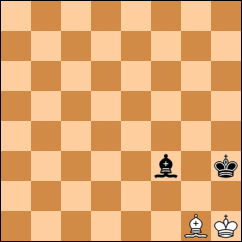
- "Because of that possibility, if my flag falls I have lost the game. That's ridiculous!"
T went on with the other endings of one piece each, knight against knight, bishop or rook, bishop against rook (where it turns out the bishop can't win).
- "You also lose with a pawn against a piece", he continued, unable to conceal his excitement.
- "Aha, because I could promote to a knight or maybe a bishop, and then corner my king. That's the silliest use of under-promotion I've ever heard of!"
The moment he pronounced the word "under-promotion", the problemist G entered the discussion. G's favorite topic was helpmates, but under-promotion would do.
- "In fact there are only two possible motives for promotion to bishop or rook", he explained, "at least if one excludes things like ridiculing one's opponent. One is offensive, to avoid stalemating the opponent in a winning position. The other is defensive, to draw by getting stalemated. You see, except when it comes to stalemate, a queen will be at least as good as a rook or a bishop." He showed them a rare example of a serious under-promotion, the famous game Bremel - Kertis, Budapest 1948:
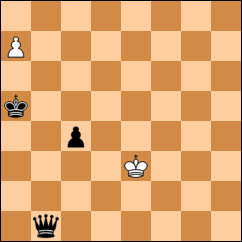
- "In this position, White won with 1. a8R+! Kb4, 2. Rb8+ Kc3 3. Rxb1. If the rook had been a queen, Black would have been stalemated at this point."
- "The defensive motive, getting oneself stalemeted, is even more exotic. It's been demonstrated numerous times in problems and studies, like this one by Traxler and Dedrle from 1909:"
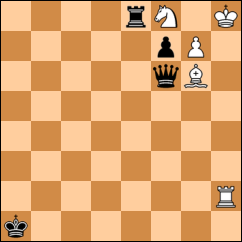
- "White draws with 1. Ra2+ Kxa2 2. Bxf7+ Qxf7 3. g8B! Rxf8 stalemate. But the defensive under-promotion is a unicorn of chess. Easy to imagine, yet nobody has seen a real one! Amazing, isn't it? Not a single defensive under-promotion is known from the millions of recorded games of chess history."
- "The most spectacular demonstrations of under-promotion are the realizations of the so-called Babson theme..."
And here he was interrupted by P, who reminded everyone that it was six o'clock and the games were about to start. It turned out that B was playing white against T. Their game became the longest of the evening, and when it was about to be decided, a small crowd had gathered in silence around the table. Black would clearly queen first, but his other race, that agianst the clock, was less certain.

In this position the game continued 61. b6 c1Q 62. b7 Qc5+ 63. Ka8 Qc6 64. a7. T now realized he would have had mate in two with 64. - Qh1 65. Kb8 Qh8 if not the stupid bishop had blocked the eighth rank. So he decided to get it out of the way. 64. - Be7 65. Kb8.
With time running out, T had already forgotten his plan and was thinking about 65. - Bd6+, but didn't see how to continue after 66. Ka8. So instead the game went 65. - Qc7+ 66. Ka8. A few minutes later in the calm of the analysis room, he would realize not only that the back-rank mate had still been possible with 65. - Qd6+ 66. Ka8 Qd5 and 67. - Qg8, but also that after 65. - Bd6+ 66. Ka8 Qa6 67. b8Q+ Bxb8, the idea that White gets yet another queen is an illusion.
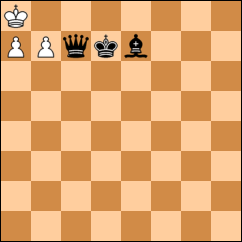
With only seconds left for the entire game, T was jumping up and down in his chair. How could it be so difficult to finish the opponent off with queen and bishop against a couple of silly pawns? He finally sighed and realized he might have to settle for a draw. With a helpless look on his face, he took a last glance at the clock, 3, 2, 1 second left. And played 66. - Qc8+.
Only at this point did B realize he might actually promote one of his pawns. With his last move, Black was clearly offering a draw, but the gentleman he was, B would still not miss an opportunity of a little prank. He reached out for the white queen, but with his eyes still focused on the board, accidentally pushed her over the edge of the table. She bounced through the little crowd and disappeared under a chair.
Never mind. For the desired effect, the move would have to be played instantly. B put one of his rooks upside down on b8, removed his b-pawn, and pressed the clock. With his hands flying nervously all over the board, T knocked his own king over, picked it up and managed to put it on d8, but the clock was already flashing with a row of zeros on Black's side.
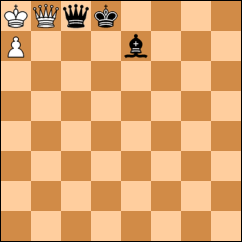
- "I seem to have lost on time", he confessed, but all of a sudden recalled what he had learnt in the weekend.
- "No, wait, it's a draw because of insufficient material!"
The following conversation was a bit confused. Some spectator argued that a rook upside down is a generally accepted substitute for a queen, while another pointed out that even a rook is sufficient material. Meanwhile, T tried to explain that since no sequence of legal moves can lead from the current position to one where the black king is checkmated, the game is drawn even though Black's flag has fallen.
They were interrupted by G, the problemist.
- "I'll be darned! Gentlemen..."
As he spoke, he swiftly turned the rook on b8 back to its normal orientation and, as the club's chairperson S had joined the group, continued:
- "...and ladies, this moment goes to history. For centuries, problemists and study composers have thought that the only motives for promotion to rook or bishop are forcing or avoiding stalemate. But tonight our friend B has demonstrated, with his extraordinary 66:th move, that there is another motive: retaining sufficient material."
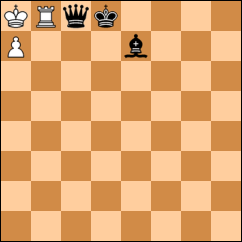
- "In the final position, with White to move after Black overstepping time, White has sufficient material because on the forced continuation 67. Rxc8+, Black has the legal move 67. - Kd7 after which he can in principle be checkmated. Had the rook on b8 been a queen, the only legal continuation would have been 67. Qxc8+ Kxc8 stalemate, and therefore 66. - Kd8 would have ended the game. The manoeuver Be7 - Kd8 was brilliant too, and would have saved the game against..."
- "I don't quite follow", said B, eager to get some coffee and gossip about the other games of the evening, "but in any case the position is dead drawn, everyone can see that."
With those words he shook T's hand, signed the protocol saying 1/2-1/2, and went to the analysis room, unaware of his unique contribution to chess history.
Epilogue
As the problemist G realized later that evening, there is yet another motive for under-promotion, that of forcing insufficient material. A while later, he published a strange little chess problem, clearly inspired by that evening's events:
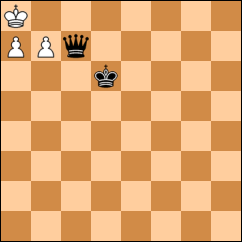
The task was unusual: Draw in 1 move.